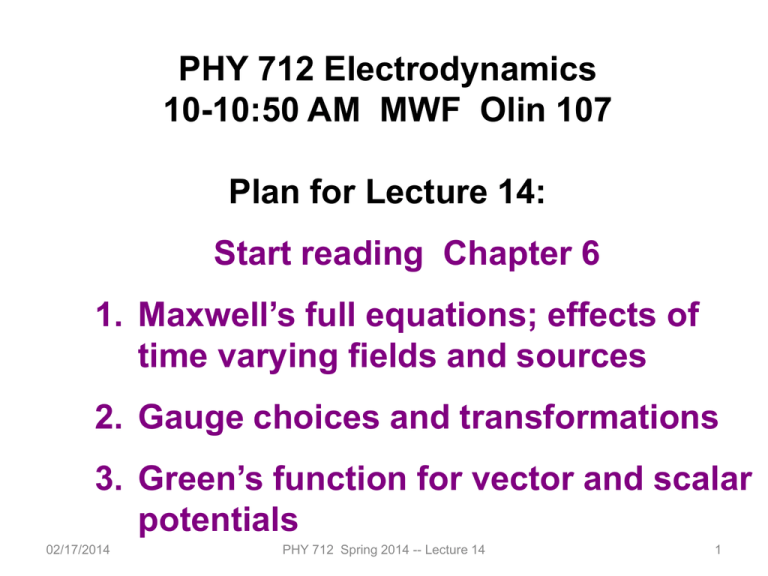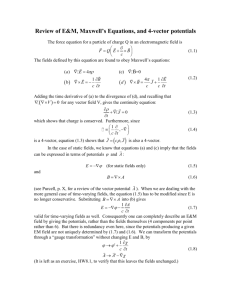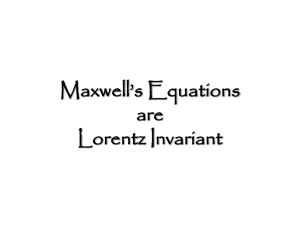Powerpoint slides
advertisement

PHY 712 Electrodynamics 10-10:50 AM MWF Olin 107 Plan for Lecture 14: Start reading Chapter 6 1. Maxwell’s full equations; effects of time varying fields and sources 2. Gauge choices and transformations 3. Green’s function for vector and scalar potentials 02/17/2014 PHY 712 Spring 2014 -- Lecture 14 1 02/17/2014 PHY 712 Spring 2014 -- Lecture 14 2 Full electrodynamics with time varying fields and sources Image of statue of James Clerk-Maxwell in Edinburgh "From a long view of the history of mankind - seen from, say, ten thousand years from now - there can be little doubt that the most significant event of the 19th century will be judged as Maxwell's discovery of the laws of electrodynamics" Richard P Feynman http://www.clerkmaxwellfoundation.org/ 02/17/2014 PHY 712 Spring 2014 -- Lecture 14 3 Coulomb' s law : D free D Ampere - Maxwell' s law : H J free t B Faraday's law : E 0 t No magnetic monopoles : B 0 02/17/2014 PHY 712 Spring 2014 -- Lecture 14 4 Microscopic or vacuum form (P 0; M 0) : Coulomb' s law : E / 0 1 E Ampere - Maxwell' s law : B 2 0 J c t B Faraday's law : E 0 t No magnetic monopoles : B 0 1 2 c 0 0 02/17/2014 PHY 712 Spring 2014 -- Lecture 14 5 Formulation of Maxwell’s equations in terms of vector and scalar potentials B 0 B A B A E 0 E 0 t t A E t A or E t 02/17/2014 PHY 712 Spring 2014 -- Lecture 14 6 Formulation of Maxwell’s equations in terms of vector and scalar potentials -- continued E / 0 : A / 0 t 1 E B 2 0 J c t 2 1 A A 2 2 0 J c t t 2 02/17/2014 PHY 712 Spring 2014 -- Lecture 14 7 Formulation of Maxwell’s equations in terms of vector and scalar potentials -- continued General form for the scalar and vector potential equations: 2 A t / 0 1 2 A A 2 2 0 J c t t Coulomb gauge form -- require A C 0 2 C / 0 2 1 A C 1 C 2 A C 2 2 0 J 2 c t c t Note that J J l J t with J l 0 and J t 0 02/17/2014 PHY 712 Spring 2014 -- Lecture 14 8 Formulation of Maxwell’s equations in terms of vector and scalar potentials -- continued Coulomb gauge form - - require A C 0 2 C / 0 2 A C 1 C 1 2 AC 2 2 0 J 2 c t c t Note that J J l J t with J l 0 and J t 0 Continuity equation for charge and current density : C Jl 0 J l 0 t t t C 1 C 2 0 0 0 J l c t t 2 AC 1 2 AC 2 0 J t 2 02/17/2014 9 c t PHY 712 Spring 2014 -- Lecture 14 Formulation of Maxwell’s equations in terms of vector and scalar potentials -- continued Analysis of the scalar and vector potential equations : A 2 / 0 t 1 2 A A 2 2 0 J c t t 1 L Lorentz gauge form - - require A L 2 0 c t 2 1 L 2 L 2 / 0 2 c t 2 1 AL 2 AL 2 0 J 2 c t 02/17/2014 PHY 712 Spring 2014 -- Lecture 14 10 Formulation of Maxwell’s equations in terms of vector and scalar potentials -- continued 1 L Lorentz gauge form - - require A L 2 0 c t 2 1 L 2 L 2 / 0 2 c t 2 1 AL 2 AL 2 0 J 2 c t Alternate potentials : A' L A L and ' L L t 2 1 2 Yields same physics provided that : 2 2 0 c t 02/17/2014 PHY 712 Spring 2014 -- Lecture 14 11 Solution of Maxwell’s equations in the Lorentz gauge 2 L 1 2 / 0 L 2 2 c t 2 AL 1 2 0 J AL 2 2 c t Consider the general form of the 3 - dimensional wave equation : 2 1 2 2 2 4f c t r, t wave field 02/17/2014 f r, t source PHY 712 Spring 2014 -- Lecture 14 12 Solution of Maxwell’s equations in the Lorentz gauge -- continued 2 1 r, t 2 r, t 2 4f r, t 2 c t Green' s function : 2 1 2 2 2 G r, t ; r ' , t ' 4 3 r r ' t t ' c t Formal solution for field r, t : r, t f 0 r, t d 3 r ' dt 'G r, t ; r ' , t ' f r ' , t ' 02/17/2014 PHY 712 Spring 2014 -- Lecture 14 13 Solution of Maxwell’s equations in the Lorentz gauge -- continued Determination of the form for the Green' s function : 2 1 2 2 2 G r, t ; r ' , t ' 4 3 r r ' t t ' c t For the case of isotropic boundary values at infinity : 1 1 G r, t ; r ' , t ' t ' t r r ' r r' c Formal solution for field r, t : r, t f 0 r, t 1 1 d r ' dt ' r r' t ' t c r r' f r' , t ' 3 02/17/2014 PHY 712 Spring 2014 -- Lecture 14 14 Solution of Maxwell’s equations in the Lorentz gauge -- continued Analysis of the Green' s function : 2 1 2 2 2 G r, t ; r ' , t ' 4 3 r r ' t t ' c t Fourier analysis in the time domain - - note that 1 t t ' 2 i t t ' d e Define : 1 G r, t ; r ' , t ' 2 d e i t t ' ~ G r, r ' , 2 2 ~ 2 G r, r ' , 4 3 r r ' c 02/17/2014 PHY 712 Spring 2014 -- Lecture 14 15 Solution of Maxwell’s equations in the Lorentz gauge -- continued Analysis of the Green' s function (continued) : 2 2 ~ 2 G r, r ' , 4 3 r r ' c For the case of isotropic boundary values at infinity : ~ ~ G r, r ' , G r r ' , ~ Further assuming that G r r ' , is isotropic in r r ' R : 1 d2 2 ~ 3 r r ' R G r , r ' , 4 2 2 c R dR 1 i R / c ~ Solution : G r, r ' , e R 02/17/2014 PHY 712 Spring 2014 -- Lecture 14 16 Solution of Maxwell’s equations in the Lorentz gauge -- continued Analysis of the Green' s function (continued) : 1 ~ i r r ' / c G r, r ' , e r r' 1 G r, t ; r ' , t ' 2 1 2 i t t ' ~ G r, r ' , i t t ' 1 i r r ' / c e r r' d e d e 1 1 r r ' 2 d e 1 1 t t ' r r ' / c t 't r r ' / c r r' r r' 02/17/2014 i t t ' r r ' / c PHY 712 Spring 2014 -- Lecture 14 17 Solution of Maxwell’s equations in the Lorentz gauge -- continued 1 G r, t ; r ' , t ' t 't r r ' / c r r' Solution for field r, t : r, t f 0 r, t 1 1 d r ' dt ' r r' t ' t c r r' f r' , t ' 3 02/17/2014 PHY 712 Spring 2014 -- Lecture 14 18 Solution of Maxwell’s equations in the Lorentz gauge -- continued Liènard-Wiechert potentials and fields -Determination of the scalar and vector potentials for a moving point particle (also see Landau and Lifshitz The Classical Theory of Fields, Chapter 8.) Consider the fields produced by the following source: a point charge q moving on a trajectory Rq(t). Charge density: (r, t ) q 3 (r R q (t )) . Current density: J (r, t ) q R q (t ) (r R q (t )), where R q (t ) 3 dR q (t ) dt Rq(t) q 02/17/2014 PHY 712 Spring 2014 -- Lecture 14 19 . Solution of Maxwell’s equations in the Lorentz gauge -- continued 1 (r, t ) 4 ò0 (r ', t ') d r 'dt ' | r r '] | t ' (t | r r ' | / c) 1 A(r, t ) 4 ò0 c 2 3 J (r ', t') d rd]rdt' ' | r r ' | t ' (t | r r ' | / c) . 3 3 We performing the integrations over first d3r’ and then dt’ making use of the fact that for any function of t’, f (tr ) dt ' f (t ') t ' (t | r R q (t ') | / c) R q (tr ) (r R q (tr )) , 1 c | r R q (tr ) | where the ``retarded time'' is defined to be tr t 02/17/2014 | r R q (tr ) | c . PHY 712 Spring 2014 -- Lecture 14 20 Solution of Maxwell’s equations in the Lorentz gauge -- continued Resulting scalar and vector potentials: q 1 (r, t ) , 4 ò0 R v R c q v A(r, t ) , 2 4 ò0 c R v R c Notation: R r R q (tr ) v R q (tr ), 02/17/2014 tr t PHY 712 Spring 2014 -- Lecture 14 | r R q (tr ) | c . 21 Solution of Maxwell’s equations in the Lorentz gauge -- continued In order to find the electric and magnetic fields, we need to evaluate A(r, t ) E(r, t ) (r, t ) t B(r, t ) A(r, t ) The trick of evaluating these derivatives is that the retarded time tr depends on position r and on itself. We can show the following results using the shorthand notation: R t r vR c R c 02/17/2014 and tr R . vR t R c PHY 712 Spring 2014 -- Lecture 14 22 Solution of Maxwell’s equations in the Lorentz gauge -- continued v2 v q 1 v R v R (r, t ) R 1 2 R R 2 , 3 4 ò0 c c vR c c R c vR v 2 v R v R vR A(r, t ) q 1 v R 2 2 R 2 . 3 t 4 ò0 Rc c c c v R c c R c q 1 E(r, t ) 3 4 ò0 v R R c vR v 2 vR v R 1 2 R R 2 . c c c c q R v v 2 v R R v / c R E(r, t ) B(r, t ) 1 2 2 3 2 2 4 ò0 c c cR v R c v R R R c c 02/17/2014 PHY 712 Spring 2014 -- Lecture 14 23



